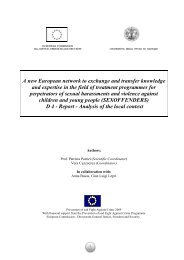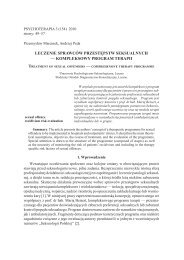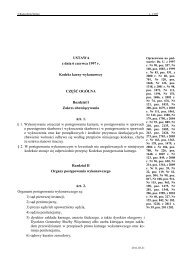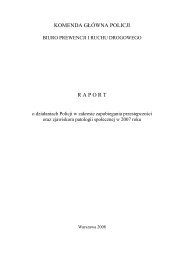ENGLISH
ENGLISH
ENGLISH
- No tags were found...
Create successful ePaper yourself
Turn your PDF publications into a flip-book with our unique Google optimized e-Paper software.
The respondents of the health sector have quite different approaches. In the answers one can find quite an inconsistencywhich might be due to the different interpretation of the term ’risk assessment instrument’. Both respondents stated that theydo not know any instruments, but when asked about their practice, one said:’In the forensic section of 2 psychiatric hospitals we use our own instrument (HCR 20). In one hospital they use a specialinstrument for children, but not for women.’And the other stated:’We do have a certain method which I would not describe as an instrument, but it works. The woman is asked certainquestions before she leaves the hospital: is she safe at home; does she need a place in a shelter; what is her situation whenshe leaves the hospital now. All nurses learn to ask these questions during the enrolment. They have written documents onthis issue at the ward, with free access for every nurse.’Leaving the term instrument aside, the result is that 10 respondents are using some kind of method to assess high risk inintimate partner violence.One of the respondents explains why they do not apply RAI:’We delegate the assessment to the intervention centre in order to leave it to the professionals on this issue.’The assessment of high risk is done in 10 organisations by a professional in the agency. But in only 3 organisations is thisassessment solely carried out by the professional. In 5 organisations, the supervisor is also involved, and in 4 agencies amultidisciplinary team participates in the assessment.One respondent explains:’The professional on standby makes the first assessment based on the Big 26. Then a further assessment is done togetherin small groups: talking again with the woman, talking to the police and so on.’Of those 10 agencies who apply a RAI (of whatever nature), 60% do so systematically.The approach of one intervention centre is outstanding:’The standard is to apply the instrument systematically at the first contact with the victim and to repeat it regularly in allcases of partner violence. Between August 2009 and December 2009 we identified 107 victims at high risk by using theDA. We have applied the DA instrument more systematically since 2009. Before that we used the Big 26 of the DAIPproject. We are serving a lot of victims of DV (we receive over 4 000 reports by the police per year). Since we have limitedresources, it is very important to be able to identify high risk victims in order to prioritise support. We decided to apply aninstrument that estimates lethal risk in order to be able to contribute to the prevention of homicides, attempted homicidesand severe violence. DA is administered electronically and the information is integrated in the client database. If the clientfile is open, the result of the last DA is visible on the first page. This way staff can see the level of danger immediately andcan react more appropriately.’Of the 40% who do not use an instrument systematically, one respondent gave an explanation in which cases exceptionsare made:’We apply the instrument in cases where women try to downplay the danger and do not perceive themselves as being at risk.’Concerning the helpfulness of the applied instrument 8 respondents gave positive answers. In the majority (5 out of 8) theanswers stress the helpfulness of the instrument in regard to the victim’s self evaluation of the danger. One respondentmentioned that it ’helps to not forget any risk factor’, another respondent appreciates ’to get a first overview’. And oneP 23






